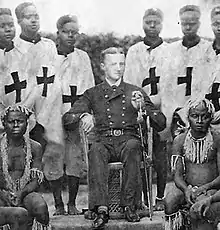Maurice Vidal Portman
Maurice Vidal Portman (21 March 1860 – 14 February 1935) was a British naval officer, who is best known for documenting several Andamanese tribes between 1879 and 1901 when he was posted as a superintendent of the Andaman Island Penal Colony.[1]

Life and career
M. V. Portman was the third son of The Honourable Maurice Berkeley Portman (of his first marriage, to Helen Vidal Harris) who was in turn the third son of Edward Portman, 1st Viscount Portman, and Emma Portman, Baroness Portman. He was born in Canada. He joined the Royal Indian Marine at the age of 16 and was some time in charge of the Viceroy's yacht. In July 1879 he was stationed at Port Blair in the Andaman Islands and made Officer in Charge of the Andamanese, a post which he held for more than 20 years with few interruptions (including December 1880 to December 1883 on sick leave, March 1887 to March 1888 on furlough).[1]
Port Blair
During his stay at Port Blair he took a large number of photographs of the Andamanese, including some at the request of British Museum (at his own expense) and the British Government of India (on payment). In order to take these photographs and document the previously uncontacted tribe, he took some indigenous people by force from the North Sentinelese islands to the South Andaman Island capital of Port Blair. Two of the people quickly died of disease, as they were previously unexposed to modern pathogens, and the children were sent back to North Sentinel after some weeks.[2] After this encounter, the North Sentinelese began to hide from him and grew increasingly hostile as a result of the kidnapping, and this incident is thought to be one of the factors that fuels the tribes' marked hostility towards outsiders. [3]
He continued to take photographs of imprisoned natives in Port Blair, documenting information about the natives' anthropological details, with a marked interest in the natives' phallic measurements. [4] [5] Much of his photography posed indigenous men nude in mock-Greek homoerotic compositions. He was greatly interested in the male Andamanese body; in his words: "...many of the men are very good-looking; as they have none of the thick lips, high cheekbones, and flat noses of the negro type; though the women are rather of the Hottentot Venus order of beauty." [6] It is unknown how many indigenous people fell sick or died as a result of his venture.
These plates are now scattered among several museums and may be partly unpublished.[1] He also wrote two books, Notes of the Languages of the South Andaman Group of Languages (1898)[7] and A History of Our Relations with the Andamanese (1899).[8] Portman also composed a significant collection of ethnographic objects during his time on the Andaman Islands that are now in the collections of the British Museum.[9]
Later life
His obituary stated that he had a "frail physique" and suffered from ill health. After retiring as an invalid in 1901, he went back to Britain where he did some journalism and "some valuable Secret Service work" during World War I.[10] He was a member of the Union Club.[10] He never married and left no descendants.[1]
References
- Weber, George. "Maurice Vidal Portman (1861-1935)". The Andamanese (Appendix A - Pioneer Biographies of the British Period to 1947). Archived from the original on 5 August 2012. Retrieved 3 July 2012.
- Portman, M. V. (1899). A History Of Our Relations With The Andamanese Vol.2. p. 232.
- International, Survival; International, Survival. "Sentinelese". www.survivalinternational.org. Retrieved 28 January 2021.
- Sen, Satadru (2009). "Savage Bodies, Civilized Pleasures: M. V. Portman and the Andamanese". American Ethnologist. 36 (2): 364–379. ISSN 0094-0496.
- "Man who made lost tribe hate the world". NewsComAu. 30 November 2018. Retrieved 28 January 2021.
- Portman, Maurice (1888). "The Exploration and Survey of the Little Andamans". Proceedings of the Royal Geographical Society and Monthly Record of Geography. 10 (9): 567–576. doi:10.2307/1800974. ISSN 0266-626X.
- M. V. Portman (1898), Notes of the Languages of the South Andaman Group of Languages
- M. V. Portman (1899), A history of our Relations with the Andamanese, Volume I and Volume II. Office of the Government Printing, Calcutta, India.
- British Museum Collection
- (1935) OBITUARY - MR. M.V. PORTMAN - "FATHER" OF ANDAMAN ISLANDERS Archived 5 August 2012 at the Wayback Machine. The Times of London, 22 February 1935. Reproduced by G. Weber in The Andamanese Archived 24 July 2013 at the Wayback Machine, Appendix A
External links
- Works by or about Maurice Vidal Portman at Internet Archive
- Savage bodies, civilized pleasures: M. V. Portman and the Andamanese, Satadru Sen, American Ethnologist, Vol. 36, No. 2, pp. 364–379, May 2009 doi:10.1111/j.1548-1425.2009.01140.x
- 13-volume collection of photos held at the British Library: Andamanese Islanders (1893): Volume I; Volume II; Volume III; Volume IV; Volume V; Volume VI; Volume VII; Volume VIII; Volume IX; Volume X; Volume XI; Volume XII; Volume XIII (Portman Collection)